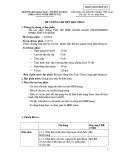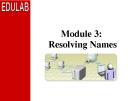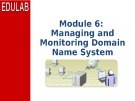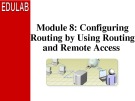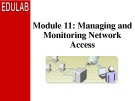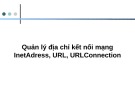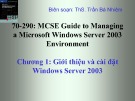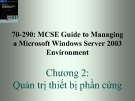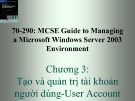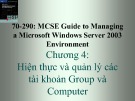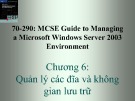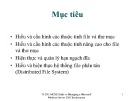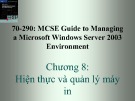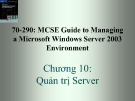Module 6: Managing and Monitoring Domain Name System
Overview
• Managing DNS Records • Testing the DNS Server Configuration • Monitoring DNS Server Performance
Lesson: Managing DNS Records
• What Is the Time to Live? • What Are Aging and Scavenging Parameters? • How Aging and Scavenging Work • Practice: Managing DNS Records
What Is the Time to Live?
The Time to Live value indicates how long a record The Time to Live value indicates how long a record should be cached should be cached
Resource Record Resource Record
Resource Record Resource Record
Zone
Cach Cach e e
Cach Cach e e DNS Server1 DNS Server1
Authoritative Authoritative DNS Server2 DNS Server2
DNS Client DNS Client
TTL set on the zone
1
The records in the zone are sent to other DNS The records in the zone are sent to other DNS servers and clients in response to queries servers and clients in response to queries
2
3
Records are cached based on the TTL period Records are cached based on the TTL period supplied in the record supplied in the record When the TTL expires, the record is removed from When the TTL expires, the record is removed from the cache the cache
What Are Aging and Scavenging Parameters?
Aging determines when a stale record should be Aging determines when a stale record should be removed from the DNS database removed from the DNS database
Scavenging removes outdated or extinct names Scavenging removes outdated or extinct names from the database from the database A refresh attempt is the process of a computer A refresh attempt is the process of a computer renewing its renewing its DNS record DNS record
DNS server does not accept refresh attempts
Parameter Description Example
No-Refresh Interval
7 days (default)
DNS server does accept refresh attempts
Refresh Interval
7 days (default)
How Aging and Scavenging Work
7 days
7 days
Jan 1
Jan 8
Jan 15
Scaven Scaven ge ge
Time Time stamp stamp
Refresh Refresh Interval Interval
No- No- Refresh Refresh Interval Interval
Aging Aging
Practice: Managing DNS Records
In this practice, you will: • Modify the default TTL for a zone • Modify the TTL for a record • Configure aging and scavenging
Lesson: Testing the DNS Server Configuration
• What Are Simple and Recursive Queries? • Why Verify That a Resource Record Exists? • What Is Nslookup? • What Is Dnscmd? • What Is Dnslint? • Practice: Testing the DNS Server Configuration
What Are Simple and Recursive Queries?
A simple query performs a local test by using the A simple query performs a local test by using the DNS client to query the DNS server DNS client to query the DNS server
A recursive query tests a DNS server by forwarding A recursive query tests a DNS server by forwarding a recursive query to another DNS server a recursive query to another DNS server
DNS Server DNS Server
DNS Root Server DNS Root Server
DNS Service DNS Service
Authoritative zone: Training.nwtraders.msft
DNS Client Resolver DNS Client Resolver
Why Verify That a Resource Record Exists?
To identify problems with your DNS To identify problems with your DNS solution, solution, you can verify: you can verify:
Missing records Missing records Incomplete records Incomplete records Incorrectly configured records Incorrectly configured records
You can use the following three tools to You can use the following three tools to monitor DNS: monitor DNS: Nslookup Nslookup Dnscmd Dnscmd Dnslint Dnslint
What Is Nslookup?
Nslookup is a command-line tool used to diagnose DNS infrastructure Nslookup is a command-line tool used to diagnose DNS infrastructure
What Is Dnscmd?
Dnscmd allows you to complete many DNS Dnscmd allows you to complete many DNS administrative tasks from the command administrative tasks from the command prompt prompt
What Is Dnslint?
The Dnslint tool can run a series of queries to help The Dnslint tool can run a series of queries to help diagnose common DNS name resolution problems diagnose common DNS name resolution problems
Practice: Testing the DNS Server Configuration
In this practice, you will: • Test DNS using a simple and
recursive query
• Verify records by using
Nslookup
• View DNS zone information by
using Dnscmd
• Test DNS by using Dnslint
Lesson: Monitoring DNS Server Performance
• Guidelines for Monitoring DNS Server
Performance by Using the Performance Console
• What Is a DNS Event Log? • What Is DNS Debug Logging? • Practice: Monitoring DNS Server Performance
Guidelines for Monitoring DNS Server Performance by Using the Performance Console
Performance counter
What to look for after a baseline is established
Any increase over the baseline may be cause for further investigation
Dynamic Update Rejected
Recursive Queries/sec
If this counter goes dramatically up or down, it should be further investigated
AXFR Request Sent
If this counter dramatically increases or decreases, it should be investigated
What Is a DNS Event Log?
A DNS event log is configured to log only DNS A DNS event log is configured to log only DNS events events
What Is DNS Debug Logging?
DNS debug logging allows for detailed DNS DNS debug logging allows for detailed DNS statistics and information to be gathered statistics and information to be gathered
Primary DNS Server1 Primary DNS Server1
Secondary DNS Server2 Secondary DNS Server2
Practice: Monitoring DNS Server Performance
In this practice, you will: • Monitor DNS by using the
Performance console
• Monitor DNS by using event logs • Configure DNS debug logging
Lab: Managing and Monitoring DNS
In this lab, you will: • Test simple and recursive queries • Verify SOA records by using Nslookup • Use Dnslint to verify name server
records
• View performance statistics by using
the Performance console • Verify DNS replication


